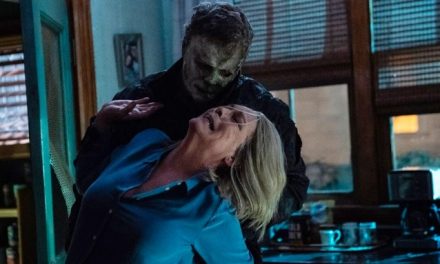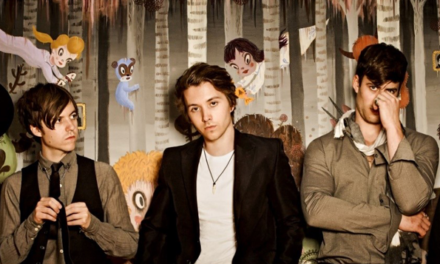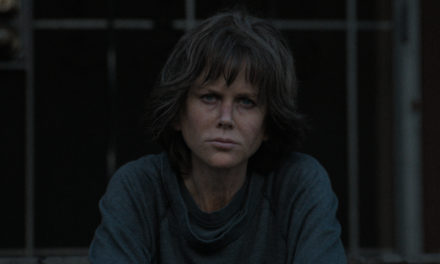Despite the name in the title, I’m only going to mention found-footage, giant monster flick Cloverfield in two paragraphs of this article, first to set your expectations. This is by no means a sequel to that film in any sense in which we use the term sequel. It carries no stylistic similarities, no creative team returns (outside of a particularly involved producer) and no narrative points of connection, minus a few deep-cut callbacks. Whether you loved or hated Cloverfield, you should free yourself from it, because 10 Cloverfield Lane certainly did.
Like Aaron Eckhart, 10 Cloverfield Lane is a surprisingly handsome Frankenstein. Assembled from equal parts of video game survival horror and classic Spielbergian thriller, it’s a strong calling card for young director Dan Trachtenberg that seems to suffer only for its clearly last-minute stitching on of studio elements, which I will return to once I sufficiently praise the brilliant indie thriller that is most of this film.
10 Cloverfield Lane takes place almost entirely in a bunker, the apparent last safe place on Earth after an unknown attack has left the air poisoned. That’s according to Howard (John Goodman), who’s taken Michelle (Mary Elizabeth Winstead) into his bunker after a car wreck, at least. Of course, anyone who takes an injured woman into a massive doomsday bunker and tells them they can’t leave should rightfully be considered suspicious, and Trachtenberg brings us down into a swirling hell of paranoia and trickery as Michelle, alongside voluntary prisoner Emmett (John Gallagher, Jr.), who came to escape the apocalypse, tries to discover what the hell is happening to the world.
From script to screen, (almost) everything about 10 Cloverfield Lane is textbook example of small, tight, well-thought-out filmmaking. There’s not an ounce of fat on the narrative; every scene has a purpose and is either a setup or a payoff or a fleshing out of the world around it. The characters are clear, interesting and laid out before us at a perfect drip.
Of course, much of that is thanks to the actors’ work here. Mary Elizabeth Winstead gives us a classic badass leading lady performance (think: Ellen Ripley from Alien or Erin from You’re Next). The job of an actor is to always be thinking — thinking through their actions and getting into the mind of their character. Michelle is always thinking and is always one step ahead of her captor. There’s a grace to the way she effortlessly glides through each challenge, yet she manages to sell each one as a mountain to overcome. In the hands of a lesser actor, Michelle could have been too static, spending too much time processing the more active world and characters around her, but Winstead never drops out of connection with the world around her. The acting is part of what takes this film from good to great.
What takes it past is (functionally) the other part of this two-hander film, John Goodman as Howard. In a just world, Goodman would be the first performance up for Oscar consideration this year. It’s a masterful display of control over the film itself, drawing every frame of the film into him like a black hole. Goodman dances effortlessly around the twists and turns the film asks of him. In a long career of quality character acting, I’m willing to call this Goodman’s best.
This film is also a sterling example of the importance of filmmaking as a craft. As much as it is an art, filmmaking is a skill: it’s a knowledge of how to compose and how to make the right decisions. It’s managing to create a narrative that creates an inherently admirable and enjoyable completion of the goals that the filmmaker trying to accomplish, before we get into the basic levels of artistic interpretation and artistic goals.
And of course, the world Trachtenberg places them in is a sight to behold. Not because it’s terribly lush, but because Trachtenberg seems to have found every nook and cranny to express the world. It’s a mood ring, reflecting the tensions and problems of the humans inside the bunker with the camera always ready to find the exact right point to focus on. No shot is unmotivated or wasted.
It’s a near-perfectly crafted, taut indie thriller with fantastic performances. It would have been an early contender for a favorite film of the year.
If it weren’t for the studio picture that got spliced into it.
Now is the time for my second mention of Cloverfield. You see, this picture was originally under the title of The Cellar when it was an industry-hot spec script, and then when it was brought onto Paramount, it became Valencia. J.J. Abrams’ involvement (thanks to the help of Bad Robot Productions) ended up grafting the film with both the Cloverfield title, and seemingly at that point, the expectations of a studio franchise film.
The studio picture that got spliced in is a sight away from the smart, tight indie thriller that is most of this movie. For the film’s runtime, it largely manifests itself in a sound design that feels designed to explain every damn thing for the audience — big loud noises and constant dramatic strings in the background of scenes that absolutely don’t need them. The sound turns this into a movie that doesn’t trust its audience, and therefore believes it needs to spell everything out for them, the nastiest tendency of cheap studio pictures.
There’s also a third act that (based on the script I read) feels spliced in out of fucking nowhere. It’s impossible to understate how unearned and unnecessary this act is. It’s not bad as a set of scenes, but it’s absolutely just there because people expect a twist of some kind. It’s a removal of ambiguities from a film that would have thrived with them.
I hate to cast aspersions on success, but there’s such a huge part of me that wishes 10 Cloverfield Lane had been the independent thriller it was intended to be. That film is propulsive, tense and wonderfully put together. As it stands, it’s still that film, but with a big ol’ zit that it doesn’t need.
Grade: B+
Opinion Editor | Brandon Wagner is a College Senior from God Only Knows Where, America studying Film and Media Studies with a minor in Religion. This is his first year for the Wheel, in a likely misguided experiment to be a film critic. When he's not writing on the biggest blockbusters or the films of Spike Jonze or Andrei Tarkovsky or Zack Snyder, he's writing on comedic television, the future of gaming as an art, or the relationship between audience and cinematic experience. In other words, Brandon Wagner has basically nothing else going on but this.







I saw the movie over the weekend, it was pretty fun. Great ending.